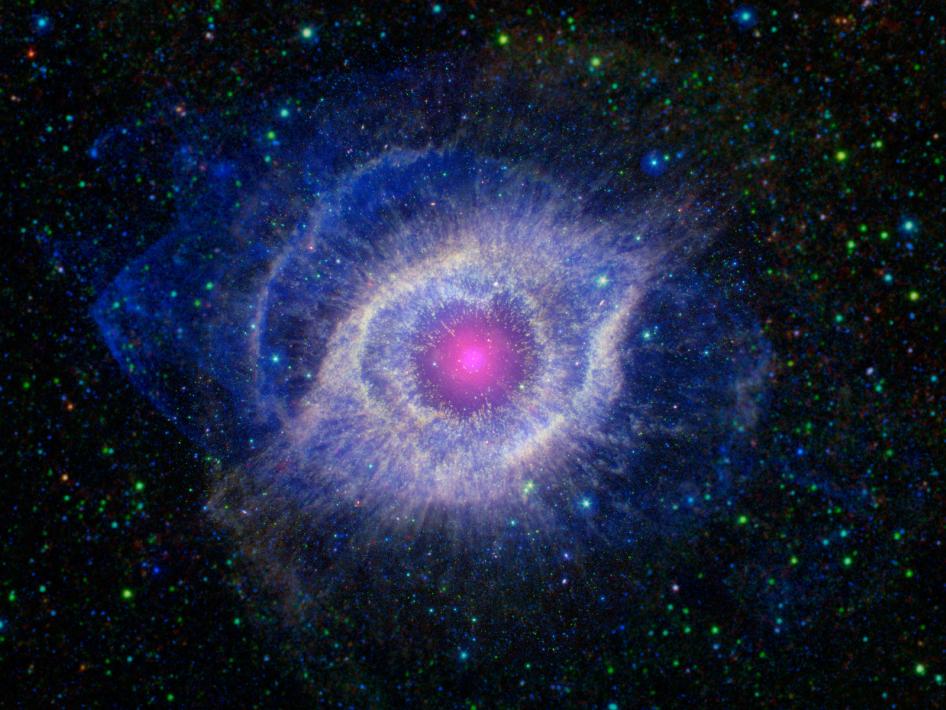
Helix Nebula - Unraveling at the Seams
A dying star is throwing a cosmic tantrum in this combined image from NASA's
Spitzer Space Telescope and the Galaxy Evolution Explorer (GALEX), which NASA
has lent to the California Institute of Technology in Pasadena. In death, the
star's dusty outer layers are unraveling into space, glowing from the intense
ultraviolet radiation being pumped out by the hot stellar core.
This
object, called the Helix nebula, lies 650 light-years away, in the constellation
of Aquarius. Also known by the catalog number NGC 7293, it is a typical example
of a class of objects called planetary nebulae. Discovered in the 18th century,
these cosmic works of art were erroneously named for their resemblance to
gas-giant planets.
Planetary nebulae are actually the remains of stars
that once looked a lot like our sun. These stars spend most of their lives
turning hydrogen into helium in massive runaway nuclear fusion reactions in
their cores. In fact, this process of fusion provides all the light and heat
that we get from our sun. Our sun will blossom into a planetary nebula when it
dies in about five billion years.
When the hydrogen fuel for the fusion
reaction runs out, the star turns to helium for a fuel source, burning it into
an even heavier mix of carbon, nitrogen and oxygen. Eventually, the helium will
also be exhausted, and the star dies, puffing off its outer gaseous layers and
leaving behind the tiny, hot, dense core, called a white dwarf. The white dwarf
is about the size of Earth, but has a mass very close to that of the original
star; in fact, a teaspoon of a white dwarf would weigh as much as a few
elephants!
The glow from planetary nebulae is particularly intriguing as
it appears surprisingly similar across a broad swath of the spectrum, from
ultraviolet to infrared. The Helix remains recognizable at any of these
wavelengths, but the combination shown here highlights some subtle differences.
The intense ultraviolet radiation from the white dwarf heats up the
expelled layers of gas, which shine brightly in the infrared. GALEX has picked
out the ultraviolet light pouring out of this system, shown throughout the
nebula in blue, while Spitzer has snagged the detailed infrared signature of the
dust and gas in yellow A portion of the extended field beyond the nebula, which
was not observed by Spitzer, is from NASA's all-sky Wide-field Infrared Survey
Explorer (WISE). The white dwarf star itself is a tiny white pinprick right at
the center of the nebula.
The brighter purple circle in the very center
is the combined ultraviolet and infrared glow of a dusty disk circling the white
dwarf (the disk itself is too small to be resolved). This dust was most likely
kicked up by comets that survived the death of their star.
Before the
star died, its comets, and possibly planets, would have orbited the star in an
orderly fashion. When the star ran out of hydrogen to burn, and blew off its
outer layers, the icy bodies and outer planets would have been tossed about and
into each other, kicking up an ongoing cosmic dust storm. Any inner planets in
the system would have burned up or been swallowed as their dying star expanded.
Infrared data from Spitzer for the central nebula is rendered in green
(wavelengths of 3.6 to 4.5 microns) and red (8 to 24 microns), with WISE data
covering the outer areas in green (3.4 to 4.5 microns) and red (12 to 22
microns). Ultraviolet data from GALEX appears as blue (0.15 to 2.3 microns).
Image Credit: NASA/JPL-Caltech
